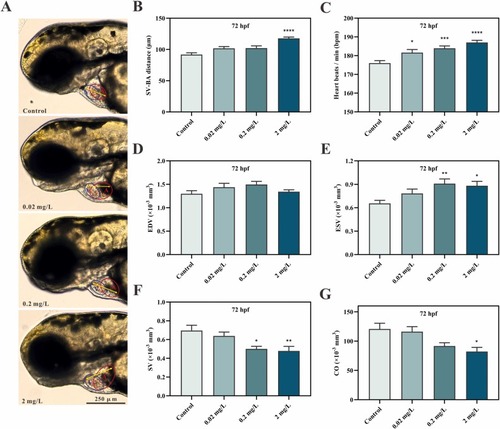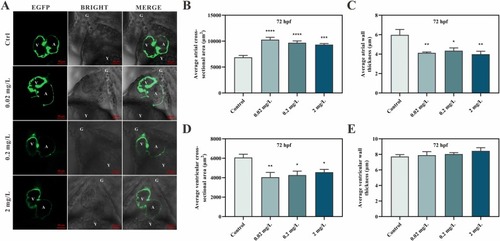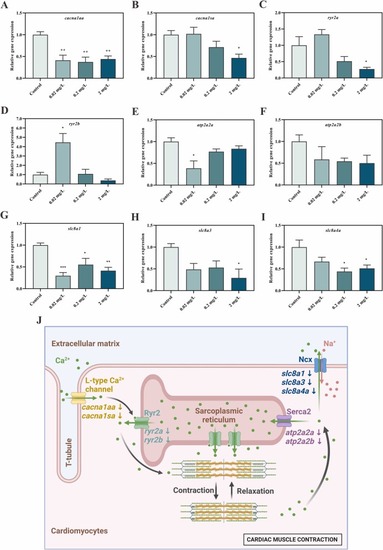- Title
-
Exposure to echimidine impairs the heart development and function of zebrafish larvae
- Authors
- Lin, T., Zhou, L., Chen, Z., Wang, L., Yang, J., Wang, S., Chen, X., Zuo, Z., He, C., Guo, L.
- Source
- Full text @ Ecotoxicol. Environ. Saf.
|
Developmental effects of zebrafish embryos exposure to echimidine. (A) Death rate from 12 to 96 hpf every 24 h. (B) Hatching rate at 48 and 52 – 72 hpf every 2 h. (C) Embryonic movement at 24 hpf; (D) Morphological changes were detected by a microscope. Scale bar: 500 µm. (E) Body length at 96 hpf. The data of death rate and hatching rate were analyzed by two-way analysis of variance (ANOVA) followed by Tukey’s multiple comparisons test and presented as the mean ± SEM (n = 6). Other data were analyzed by one-way analysis of variance (ANOVA) followed by Tukey’s multiple comparisons test and presented as the mean ± SEM (n ≥ 25). * p < 0.05, ** p < 0.01, *** p < 0.001 and **** p < 0.0001. |
|
Cardiac function of zebrafish larvae exposed to echimidine for 72 h. (A) Pericardium of zebrafish photographed by a microscope. Scale bar: 250 µm. (B) The distance between the venous sinus and the arterial bulb (SV-BA) of zebrafish. (C) Heart rate. (D) Volume of end-diastole (EDV). (E) Volume of end-systole (ESV). (F) Stroke volume (SV). (G) Cardiac output (CO). The data were analyzed by one-way analysis of variance (ANOVA) followed by Tukey’s multiple comparisons test and presented as the mean ± SEM (n ≥ 25). * p < 0.05, ** p < 0.01, *** p < 0.001 and **** p < 0.0001. |
|
Cardiac morphogenesis of zebrafish larvae exposed to echimidine for 72 h. (A) Heart morphology of Tg(cmlc2:EGFP) zebrafish exposed to 0.02, 0.2 and 2 mg/L echimidine at 72 hpf. A, atrium; V, ventricle; G, gill; Y, yolk sac. (B) Average atrial cross-sectional area. (C) Average atrial wall thickness. (D) Average ventricular cross-sectional area. (E) Average ventricular wall thickness. The data were analyzed by one-way analysis of variance (ANOVA) followed by Tukey’ s multiple comparisons test and presented as the mean ± SEM (n = 10). * p < 0.05, ** p < 0.01, *** p < 0.001 and **** p < 0.0001. |
|
The expression levels of cardiac-development-related genes in zebrafish larvae exposed to echimidine for 72 h. (A) gata4; (B) tbx5; (C) nkx2.5; (D) myh6. Values were normalized against gapdh. The data were analyzed by one-way analysis of variance (ANOVA) followed by Tukey’s multiple comparisons test and presented as the mean ± SEM (n = 3). * p < 0.05, ** p < 0.01, *** p < 0.001 and **** p < 0.0001. |
|
Echimidine exposure impairs the gene expression of calcium signaling pathway. (A-I) Gene expression of calcium signaling pathway in zebrafish larvae exposed to echimidine for 72 h. Values were normalized against gapdh. The data were analyzed by one-way analysis of variance (ANOVA) followed by Tukey’s multiple comparisons test and presented as the mean ± SEM (n = 3). * p < 0.05, ** p < 0.01, *** p < 0.001 and **** p < 0.0001. (J) The proposed mechanism of echimidine affecting the contraction of cardiomyocytes in zebrafish larvae. Echimidine exposure initially reduces the mRNA expression of cacna1aa and cacna1sa in L-type voltage-dependent calcium channels, resulting in a reduced influx of calcium ions from extracellular mediators into the cytoplasmic matrix. As a consequence, it delays the opening of the calcium channel Ryr2, which needs to bind to calcium ions on the sarcoplasmic reticulum (SR) membrane. Additionally, the mRNA expression of ryr2a and ryr2b also decreased after echimidine exposure. These combined effects seriously hinder the release of calcium from the SR in cardiomyocytes, leading to a relative decrease in cytoplasmic calcium concentration. This relative decrease in calcium concentration disrupts the binding rate of troponin and calcium, restricting the sliding of thick and thin myofilaments and ultimately impairing the contractile ability of cardiomyocytes. |





